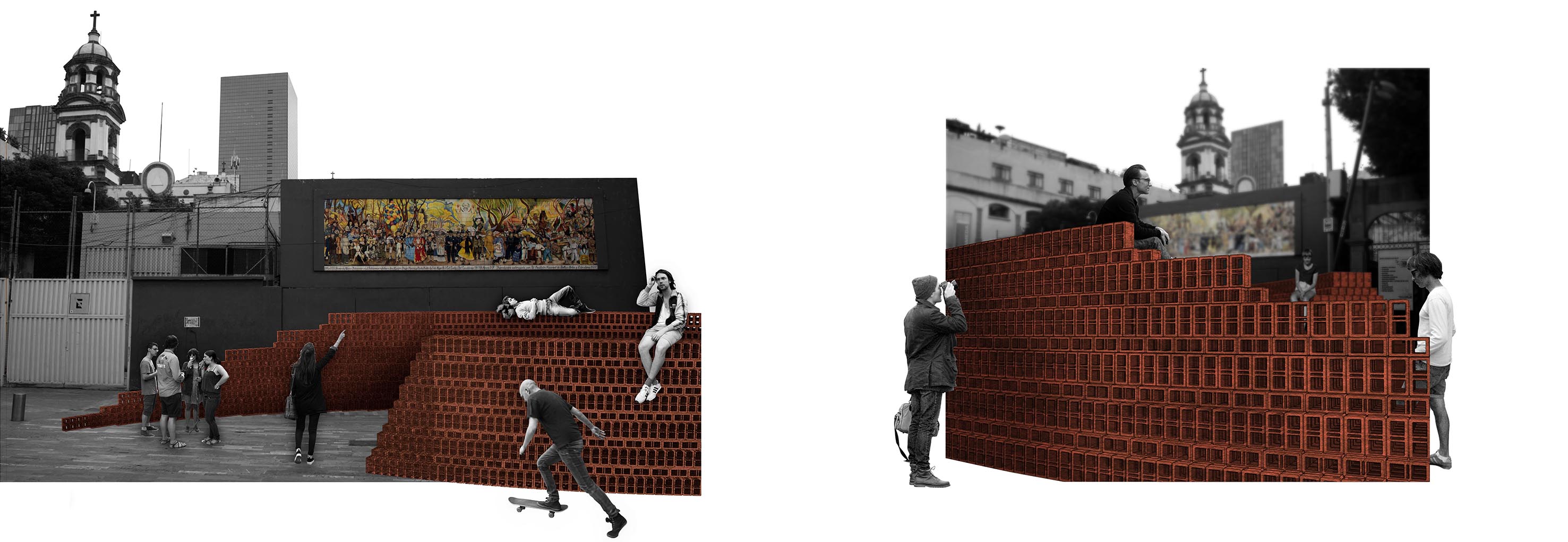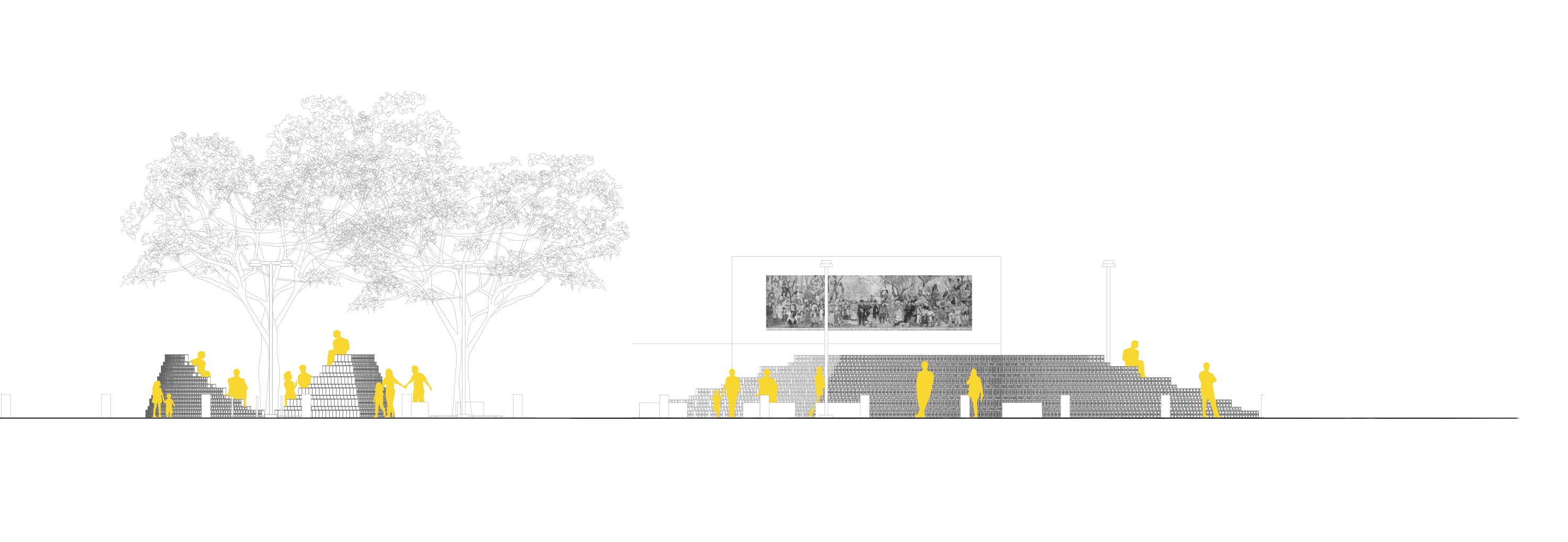
TOOLS#4: REDUCE - REUSE - RECYCLE
How to bring sustainability into the architectural process?
22 Jan 2019, Mexico City, Mexico
SLOT took part in the most recent Pabellón Mextrópoli competition. Given that one of the main preliminary conditions for this event was the usage of recycled materials, our design performed as a manifest against the idea that recycling materials is always the ecological answer par excellence. We think, on the contrary, that recycling waste is an act of indulgence, because when we recycle we, as a matter of fact, are allowing or even encouraging the generation of more and more waste. A pavilion is an opportunity to diffuse a message; our proposition tends to denounce the excessive consumption of materials.
In general terms, we avoided the production of unnecessary waste by assuring the pavilion a second life after its one-time use in Mextrópoli. Our project, called “El pabellón sin rastro” –the pavilion without remnants– is only made of bricks and natural ropes. With it, we intend to enter the ecological debate with a 'voice' arising from the design in itself, rising questions about the use of materials. This pavilion is an 'architectural moment' that takes advantage of a 'moment of use' from the material.
The quest for ‘greener cities’ should not be taken as a dictation of the authority; the citizens must cooperate, because the future of our planet is a shared responsability. This pavilion, finally, is the outline of an agora, a section of a forum in which public matters can be debated.


RECYCLING IS A BIG BUSINESS
As every new opportunity and social trends, Recycling became a business opportunity. In Mexico City, the concept for a recycling device –Biobox– is an example: you lay plastic bottles, caps and straws inside the machine; in return, you get coupons and discounts. The bottom-line: this kind of initiative is yet another attempt to make overconsumption more acceptable.
Another example, from the textile industry: in European cities you can easily find several public bins exclusively intended to receive old clothes and shoes. Once collected, the textiles are transferred to Morocco and get sorted for a future use:
• Premium shoes and clothes will be resold at a high price in the European market.
• Basic items will be sold by weight in European thrift shops.
• Destroyed items will be turned into other products, such as carpets or isolation material.
The energy wasted to transfer these items make the whole process questionable, from the ecological point of view.
We have to admit that Mexico could be an exception: garbage generated in Mexican cities has always been a source of income. Furniture easily finds a second life through social links Mexicans naturally make or across several websites dedicated to the second-hand market. From metallic cans to plastic bottles, most of the garbage is sorted and sold; these products steadily come back to their status of material when they find a price per kilogram.
In the transit between Tijuana and San Diego, the architect Teddy Cruz produced a whole study about the opportunity 'Californian garbage’ represents to Tijuana’s precarious architecture. The project he conceptualized in 2008 –Manufactured Sites– offers several possibilities adjusted to the common garbage produced in the United States.
THE MATERIAL AS AN ECONOMICAL OPPORTUNITY
Maybe you heard about it… An urban legend says that the Guggenheim Museum in Bilbao –designed by Frank O. Gehry– is made of titanium, a perceptibly eccentric material, because at the time the building was being conceptualized titanium was seemly cheap in international markets. It’s funny to see how economic, cultural or historical issues can influence the destiny of a project. Using cheap materials –and therefore recycled ones– is often an opportunity for young architects to create interesting projects.
The Ricola Storage Building, one of the first œuvres of Herzog & De Meuron, uses cheap, easily-assembled materials and propose a bold plastic expression in the façade. At the end, the intention of using low-price materials –due to budget concerns, firstly– can have an interesting consequence: high-quality Architettura Povera.

Rural Studio produced another fine example of opportunistic architecture. Their 20K Houses Experiments –a series of 12 houses built between 2005 and 2011– are determined by radical economic concerns. The architects set their own rules in the designing process: whether they get only 20,000 dollars to build a house, or their materials must come from a near-by place, or they must satisfy their client’s expectations and needs applying only the easiest constructive systems and employing amateur workers or volunteers.
The constraints are –or should be– a creative incentive. They allow the creator to focus on what’s relevant. In the domains of Architecture, unlimited freedom –from context, clients’ expectations, budget– can produce a variation of the “white page syndrome” that usually afflicts writers. Limits, on the other hand, concentrate the possibilities within a smaller field of choices and then force the architect to find a way to design something innovative.
FROM THE MATERIAL TO THE CONCEPT
The materiality of things, so to speak, often appears in front of the architect at the end of the process: it is never shown on plans, drawings or sections –sometimes in models–. We usually have material concerns when a render or a specification is required. If using second-hand materials is the architect's specific intention, then the whole project has to be guided by this direction.
But don’t forget that producing architecture from second-hand materials has intrinsically an element of randomness, something that the architect can’t fully control. When the architect designs a building with new materials, he or she can expect that the concrete, steel, glass or prefabricated items (windows, doors…) are going to be available. New materials or products have a regular price, customary sizes and follow a set of specifications and norms; things that second-hand products can’t ensure.
When the architect is looking for a second-hand material, he or she has to anticipate its availability. Maybe it has to be purchased before any work begins, and stock up on it. The design has to take into account different specifications. This process takes an amount of time, anticipation and organization that maybe the architect is not ready to manage.
THE MATERIAL FOR ITS MEANING
The use of recycled materials is not related necessarily to an economic or ecological concern. It can have other intentions behind.
The project Oktavilla, designed by Elding Oscarson, takes recycling for its didactic potential. A media company wanted to move its operations to a former textile factory, so they put Oscarson in charge of the renovation. He decided to give new life to the waste magazines the company had accumulated: they became a massive wall that divided strategic spaces, to the astonishment of clients and visitors.
In a very different scale, Europa, the new headquarters of the Council of the European Union –designed by the Belgian agency Samyn and Partners– use an impressive amount of second-hand windows to erect the main envelop. This collection of windows came from every country of the EU, unfolding great symbolic strength and revealing the real purpose and functionality of the building. The whole production ended up in the hands of an antiquarian from Brussels, who collected windows throughout all Europe, stock them up and took measures of each one of them.
If modernists said form follows function; we – in this case – can reply: material follows intention.
THE REUSE OF MATERIALS: SUITABLE SITUATIONS
Therefore, recycling is particularly appropriate for projects with public purposes, such as pavilions, festivals or installations. Public spaces also bring up great opportunities. Sustainable construction is problematic in many public and private buildings, for a number of reasons: security norms or simply because of the nature of the investment. It is easier to adapt this kind of solution in street furniture projects; in other words, in projects that don’t imply the ownership and responsibility of one client or a group of investors: public gardens, artistic installation, land art or street art.
Take, for example, the benches that Jorge Yázkip designed for the Historic Center of Mexico City: they use huge blocks of marble that came from the remains of a close down factory. The size of this material is hardly applicable to commercial architecture.

Transcript & Edition: Romain Roy-Pinot & Pablo García
Graphic Design: Romain Roy-Pinot
Discussion Team: Erick Amaro, Carolina Arellano, Ana Laura Arista, Alberto Bautista Che, Raquel Cruz, Pablo García, Miguel Ángel Jiménez, José Moreno, Romain Roy-Pinot & Víctor Zúñiga

